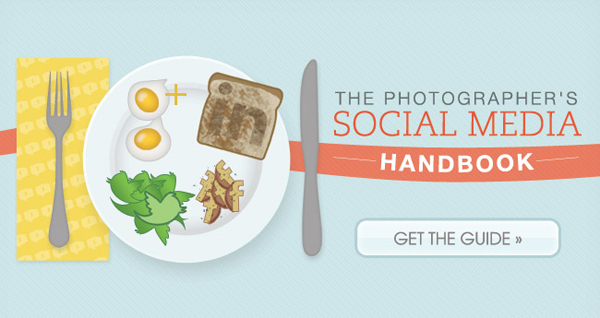Share
The Future of Social Media & Your Photo Business
We’re in the middle of a paradigm shift in social networks. We’re moving away from text-heavy content to that which is more visually appealing ...

We’re in the middle of a paradigm shift in social networks. We’re moving away from text-heavy content to that which is more visually appealing – photos, graphics, videos, GIF animations, etc. This new-found focus on imagery is a unique opportunity for photographers to boost brand awareness and their following on social media, while increasing the likelihood of acquiring new clients and sales.
The possibilities are endless, but to help keep you focused, here’s some insight on how to use them to build and promote your photo brand.
The new kids on the block
By now you’ve probably heard of two “hot” visual-based networks that photographers are utilizing to grow their photography businesses: Instagram and Tumblr. A great advantage to these two networks is that you already have a lot of visual content that you can utilize in order to build your following. These networks are simple and easy to use, so they can be easily incorporated into your daily workflow if you decide that they fit with your brand and overall marketing strategy.
Instagram:
Let’s dive into Instagram first. This platform is exclusively mobile (unless you’re using a third party site to access Instagram feeds) and based around sharing only photos shot with an iOS device or compatible Android device. On Instagram you can apply filters to your photos to make them more appealing, so users feel like they’re putting a lot of thought into the entire experience.
Instagram is an example of the shift that we’re talking about – the app is based exclusively on visuals, social sharing, and social interaction. This formula has proven to be successful; Instagram was the fastest growing (and most populated) mobile-social network on iOS and is now one of the largest launches of an app for the Android platform, with roughly 6 million downloads in less than seven days. Not to mention that Instagram was recently purchased by a little company called Facebook for $1 billion and has 5 million photos uploaded on a daily basis.
Come on, who doesn’t love photos of sleeping puppies?
The point to having your photo brand on Instagram is not necessarily to sell your Instagram prints (which you can do), but to build the number of followers who could turn into sales or a viable sources of word-of-mouth marketing for your photo business. You can also link your Instagram account directly to your Facebook, Twitter, Tumblr, and more for direct uploads and provide your followers with a link to your personal website so they can continue to engage your photo brand.
(Read Allen’s opinion on the platform in: “Why Instagram is Terrible for Photographers, and Why You Should Use It“)
Tumblr:
You almost certainly know at least one person with a Tumblr blog (Tumblog) these days. Tumblogs and the Tumblr feed place a serious emphasis on visuals and sharing. That’s because the major function on Tumblr is to “reblog,” meaning to repost another user’s content onto your own blog with a backlink to their page. So when other users reblog content, the originator still gets the credit. You can also “like” posts on Tumblr by clicking on the heart icon that accompanies the post. The amount of reblogs and likes that you have together are called “notes” and are displayed on the top of each post for all to see.

What you want your notes to look like on Tumblr.
Using Tumblr, you can quickly grow your following because as you accumulate more reblogs and likes, your post move up in the Tumbl’s popular posts – thus giving you a greater chance of being reblogged and gaining more exposure. Tumblr feeds are grouped by category (animals, fashion, film, food, etc.) and if you give one a browse, you’ll notice that nearly all of the posts that have achieved substantial recognition are visually based.
It’s clear that building a following on Tumblr based on a visual talent is a great way to communicate the value of your photography brand. Be sure to watermark your photos that you put on Tumblr with your name, website or blog ID so that you prevent stealing or claiming credit for your work.
Takeaway:
It feels as if we see a new social media platform pop up every day, and the ones that already have an established network are constantly updating and reworking themselves in order to keep up (or, in the case of Facebook, acquiring new talent). Given that these massive networks are adapting to the changing social media landscape, photographers have to keep up as well. In order to keep their standing in the social web, they have to continue to adapt with the changing times, by improving on their visual content presentation.
The “old” favorites
If you need more proof of the the expanding and increasing importance of visuals in social networks, look no further than the established social web heavyweights: Facebook and Twitter. Twitter lacks an intimate visual experience, while Facebook is constantly making improvements to make its visual presentation more interesting and engaging, which your photo business can take advantage of.
Facebook:
On Facebook we see a constant evolution of their visual aspects in order to deliver a more engaging experience for both you and the people who visit your page. The Cover Photo, Tabs, and larger image thumbnails on your Timeline are just a few of the ways Facebook is improving the network’s visual capabilities. We covered these (and more) in Facebook Timeline: 5 New Tools For Your Photo Brand.
Lets not forget Facebook’s photo-viewing interface, which is always changing so that your following can really experience your photos. Nico Morgan has a great shot of this jockey in a tranquil setting that his followers can’t take their eyes off of:
By bringing the photo to the foreground of the page, “mounting” it on a black background, and dimming-out the Facebook profile in the background, users have a chance to really see and engage with your photos without being distracted by other areas of the site.
Facebook very recently coughed up an impressive $1 billion to acquire Instagram. While the future of Instagram is questionable, this acquisition is no doubt an attempt to enhance Facebook’s photographic and visual potential. Who knows – maybe you’ll be Instagram-ing your Facebook photos in the near future, or perhaps we’ll see a dedicated tool for a Facebook “photofeed” or “photostream” develop out of this (maybe even an app?).
Twitter:
Twitter isn’t as visually strong as other networks yet, but they are clearly making their way in that direction. The “new Twitter,” introduced a few months ago, now allows you to access a “View [media]” link within your feed (think mostly photos and videos).

Alison Turner frequently sends out her Instagrams via her Twitter account.
When her followers want to view the photo, they have to click “View photo.”
If you were to post a photograph on Twitter right now, you would have to click “View photo” on the bottom of that tweet in order to see that photo. As of right now, your photographs are still not embedded-able directly into the tweet, but this is definitely a step up from the “old Twitter” where you had to click-through a link in order to view additional content.
Twitter at its core is still a great way to delivery timely content to your followers. The potential to build brand awareness on this social networking platform for photographers is very real, and will serve as a benefit as it continues to adapt to the changing social web landscape.
Final Takeaways
Visual content is becoming increasingly important on social networks and it will more than likely continue to grow because of its ability to quickly engage and draw in users. In the news, you often hear about the spread of viral videos or photos that have made headlines, and they often get their start on social media. Visuals are the key to your future success on social networks, so just be sure that you’re educated and prepared for the opportunity.
Without images, you slash your chances of making an impact online. And you can’t pass that up. For more info to help grow your photography business online, check out PhotoShelter’s recent two-part free guide, The Photographer’s Social Media Handbook.






